Brief

The simple farming techniques that we call Agriculture 1.0 prevailed for millennia, until a succession of developments—ranging from seed genetics and fertilization to modern irrigation and mechanization—built the basis for Agriculture 2.0. Those advances spawned a productivity revolution that enabled countries such as Argentina to increase their tonnage by more than 7% each year since the late 1980s.
Enter Agriculture 3.0, with its state-of-the-art digital capabilities that represent the biggest advances in decades. Agriculture companies, including growers, equipment manufacturers, input providers and new technology-focused entrants, are turning to digital techniques for the next wave of yield and efficiency improvements. Sensor-connected crops, fields, machinery and livestock give farmers greater visibility into their operations, far surpassing previously available data collection methods. Software suites analyze the collected data and help farmers make better, faster decisions. Remote- or machine-controlled farm equipment allows for more precision operations and significant reductions in labor costs.
These and other new technologies arrive at a critical moment in history. Population and consumption growth in developing nations is expected to push crop demand nearly 50% higher than the 2010 level by 2050 (see Figure 1). The exploding demand for food will require a corresponding rise in the global supply produced, especially from developing nations like China, Brazil, Argentina and India—the key countries in the equation.
But can they meet the challenge? To feed the world, governments everywhere need to help growers make optimal use of their land and improve yield efficiency, leapfrogging into the wonders of Agriculture 3.0 (see the sidebar “Agriculture 3.0, explained”). Yet most countries still need to expand their best practices for Agriculture 2.0 before they can even think of deploying new techniques to bring their agriculture sectors to full potential. The challenge is particularly great in the developing countries of Latin America, Asia and Africa, where a limited understanding of what they could achieve prevents the different stakeholders from advancing together toward a more ambitious agenda.
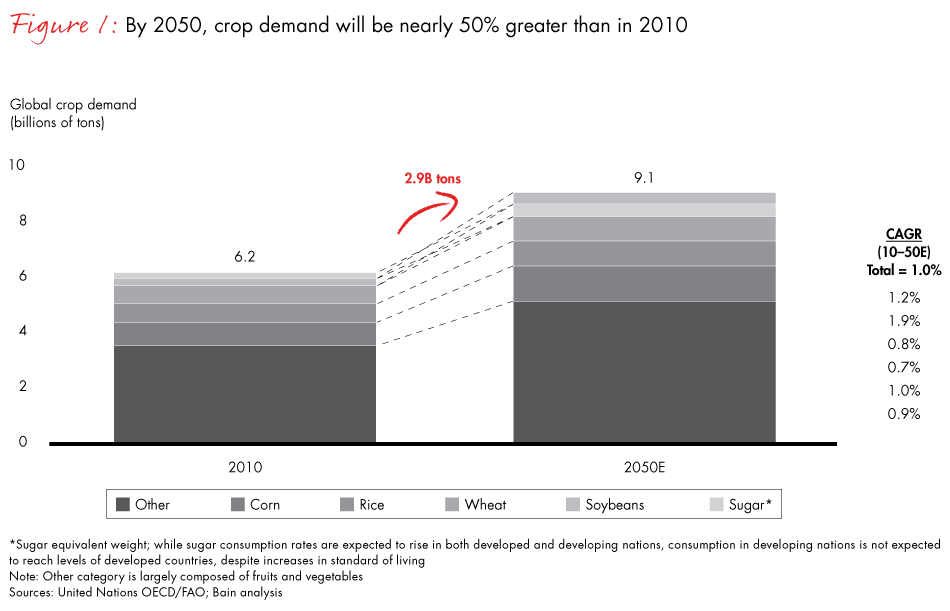
Bain & Company research shows that the majority of countries unintentionally restrict themselves from creating substantial economic value from their agriculture in two fundamental ways.
First, many countries still manage their agriculture sectors based on tradition and empirical knowledge, rather than a comprehensive analytical approach. For example, it is common for countries to view each crop independently, focusing on maximizing the output for that specific crop, without determining the potential trade-offs of growing competing—and equally viable—crops on the same land. Indeed, regardless of a country’s level of agricultural advancement, there’s a crucial (and tricky) first step in the journey to full potential: clearly understanding the best options. Would a particular country derive more socioeconomic benefits by growing sugarcane on land now used for raising cattle, for example? Or would the country be better off if it instead used that land to grow cocoa trees and integrate downstream with the export chocolate business, even considering the five years typically required for cocoa to start generating cash flow?
The second issue: A lack of coordination among the many stakeholders—including local governments, sector agencies, farmers, NGOs and multinational organizations like the United Nations—can thwart efforts. All have their own agendas and, sometimes, conflicting goals. Consider how different stakeholders would likely react when a certain crop faces a cyclical loss of competitiveness. Farmers and trade associations might press for tactical protectionist measures, whereas a multinational organization might focus on building the structural foundations of fair trade by promoting true competition. Meanwhile, an NGO might be more interested in the social impact of diminished income through that crop.
Solving these fundamental problems starts when governments understand the broader strategic picture of full-potential agriculture and align that vision with private industry (see the sidebars “Why it’s government’s role” and “Getting started”). Regardless of the type of government, several elements must be in place before the sector can progress from Agriculture 1.0 to Agriculture 3.0. Those elements include development of logistics infrastructure, appropriate financing and insurance tools, and market liquidity and access (avoiding bottlenecks through intermediaries that ultimately harm farmers), along with addressing the often thorny issue of land ownership. Among the examples of government actions that have helped advance agriculture: Brazil’s ethanol program, which transitioned from heavy incentives in the 1970s to full market dynamics today.
In the absence of government and private-sector alignment, however, even the best intentions and efforts fail to deliver significant results. Consider that Brazil’s annual tonnage increased by only 2.2% between 2009 and 2014. Chile was slightly more productive, with a 2.6% growth rate, while Colombia’s tonnage grew by only 1.2%.
Working with governments around the world, Bain has found that the most effective countries systematically address these obstacles, stepping up to the challenge of feeding the world while improving their economies. For most countries, the size of the prize is as great as doubling agro-industrial GDP, coupled with substantial job creation. Our analysis shows that, in developing countries, a twofold increase in agro-industrial GDP can generate enough jobs to reduce total unemployment by 25%.
Achieving such benefits requires defining the particular agro-industrial strategy that will yield the best results. The first major step for any country is to complete an area prioritization exercise, using Big Data and evolving digital capabilities to evaluate the agro-ecological characteristics of fertile micro-segments of its land.1 Looking at plots as small as 2 hectares or as large as 200 hectares, it can determine the potential productivity of competing crops in fine detail. Next, it needs to factor in the socioeconomic value of each crop—not only what it contributes to employment but also to primary GDP (through the agricultural production itself) and potential downstream GDP (through the processing, refining and manufacturing associated with the crop), together with the profits it generates for the farmer. With that analysis in hand, a government can gauge the best use of land and the specific trade-offs between the options—essential for promoting a long-term agro-industrial agenda, defining the most appropriate incentive policies and engaging all stakeholders.
This approach optimizes the economic results for export-oriented countries, like those of Latin America, as well as countries aiming for self-sufficiency. It takes into account the mix of crops that would yield the largest economic benefit, including the trade-off between producing what you do best and importing what you need, or producing locally what you need in lieu of exports.
While we have worked with government clients throughout the world to advance their agricultural agendas, the experience of one Latin American country best illustrates how a government can use the method to obtain a clear view of its full potential.
Relying on agro-ecological information, this Latin American government ranked the potential yields (marginal, moderate or optimal) for crops such as cocoa, bananas, coffee and palm, covering more than 60,000 polygons of fertile land that wasn’t part of natural reserves or parks, or otherwise protected (see Figures 2 and 3). With the help of Agriculture 3.0 techniques, it then took an important giant step: It compared the potential yields among those different crops to determine the winner in each of the polygons. Why is it so rare for governments to take the simple step of comparing the potentials for different crops? As we mentioned, most countries have a siloed approach to crop management, and, lacking tools and proper governance, there’s little incentive for cooperation among teams tasked with different crops. As a result, countries tend to give minimal thought to the trade-offs among those crops.
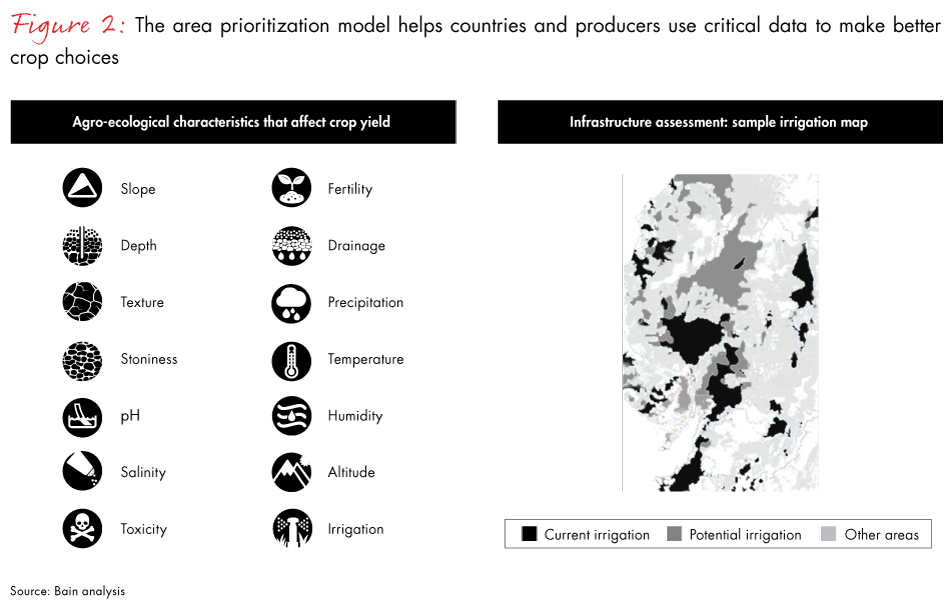
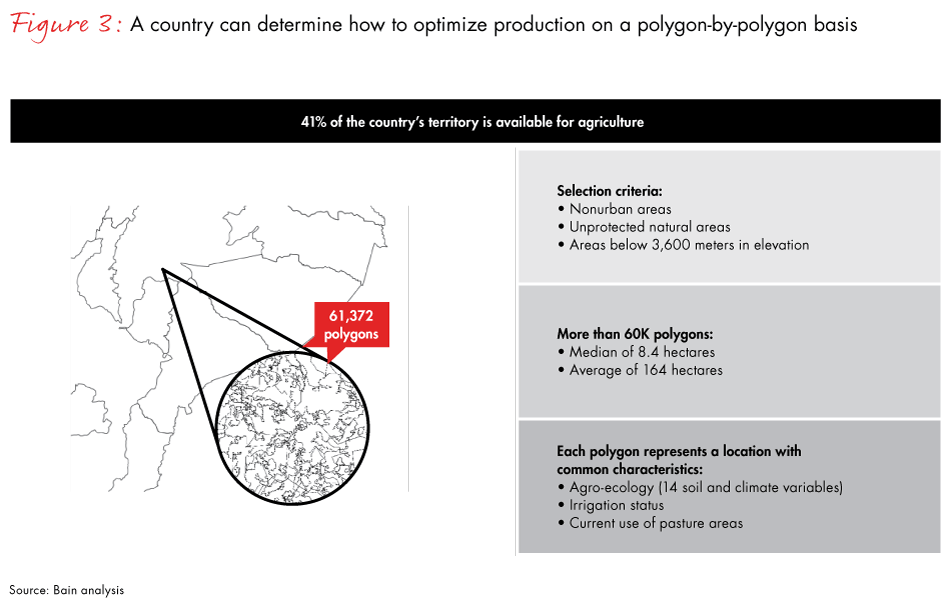
As part of its systematic approach, the Latin American country not only considered how it could maximize producer margins but also broadened the view of each crop in each land area by evaluating the potential for downstream integration. For example, based on agricultural output and producer margins alone, bananas seemed like the best crop for many polygons. However, by analyzing the crop’s value chain and the processes and products involved, the country discovered that bananas offered significantly less opportunity than cocoa for downstream development beyond the primary crop. While processing of bananas included a limited number of products such as sweets and flour, cocoa offered far more downstream opportunity for expanding production and activities in products and subproducts—everything from cocoa butter and industrial chocolate to cocoa shells and fertilizer (see Figure 4). In fact, the agro-industrial multiplier for cocoa was 2.50, more than twice the 1.05 level for bananas. The agro-industrial multiplier (agricultural GDP plus related industrial GDP, divided by agricultural GDP) provides a much broader and more realistic indication than the primary agricultural GDP of a crop’s potential overall contribution.
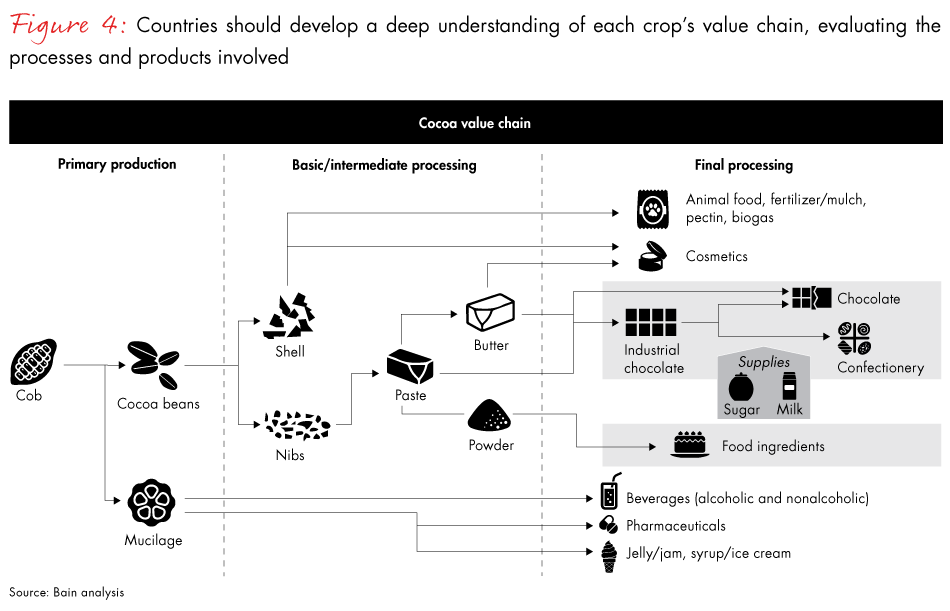
Beyond this first result, a host of additional considerations came into play. In this case, the government factored in the opportunity cost of switching from one crop to another, taking into account the cost of eliminating the initial crop and planting the new one, along with the number of nonproductive years, which is especially critical for crops like cocoa and palm. In the four or five years it takes a new palm tree to start ramping up production, for example, the producer would miss the profits that an annual crop like corn would have generated. Palm may be more attractive in the long run, but it’s an unrealistic option for a farmer who is either insufficiently capitalized or who can’t obtain adequate financing to navigate through that cashless period. Other countries will have their own considerations to accommodate, such as the role of indigenous farming in the social fabric of a community, or environmental issues such as maintaining corridors for wildlife migration.
The Latin American government then looked at its findings in light of the country’s overall economic priorities. It needed to make a choice. It compared the potential effects of each crop on the country’s primary agricultural GDP, the related agro-industrial GDP, wages and producer margins. In the end, producer margins became the top criterion for making trade-offs: It was best for convincing farmers about proposed area redistributions, reassuring them that they would be able to take care of their own needs first.
This analysis provided a clear picture of the specific productivity, crop-switch and infrastructure initiatives (such as irrigation and roads) the country would need to implement, as well as how it could integrate the more advanced techniques of Agriculture 3.0. As a result, the government could develop a much stronger set of incentive policies tailored to farmers’ specific challenges, enhancing their competitiveness while promoting the best outcome for the country.
Finally, the government needed to consider implementation challenges and find a way to prevent the false starts, stalls and duplication of efforts that come with weak governance. It laid out a strong governance structure involving both public and private stakeholders, with well-defined key performance indicators to track progress for all parties. Under the plan, parties spanning government ministries, private-sector representatives, trade associations, development agencies and NGOs come together from the strategy definition stage all the way to execution in the fields.
The Latin American country now has a solid plan in place that could double its agro-industrial GDP within the next 15 years, in our estimate (see Figure 5). By systematically bringing its crop productivity and downstream integration to full potential, it stands to become an unexpected agricultural leader, proving that tackling the daunting food challenge can yield major rewards: boosting employment by more than 200,000 jobs and increasing GDP, while delivering on the growing demand for food.
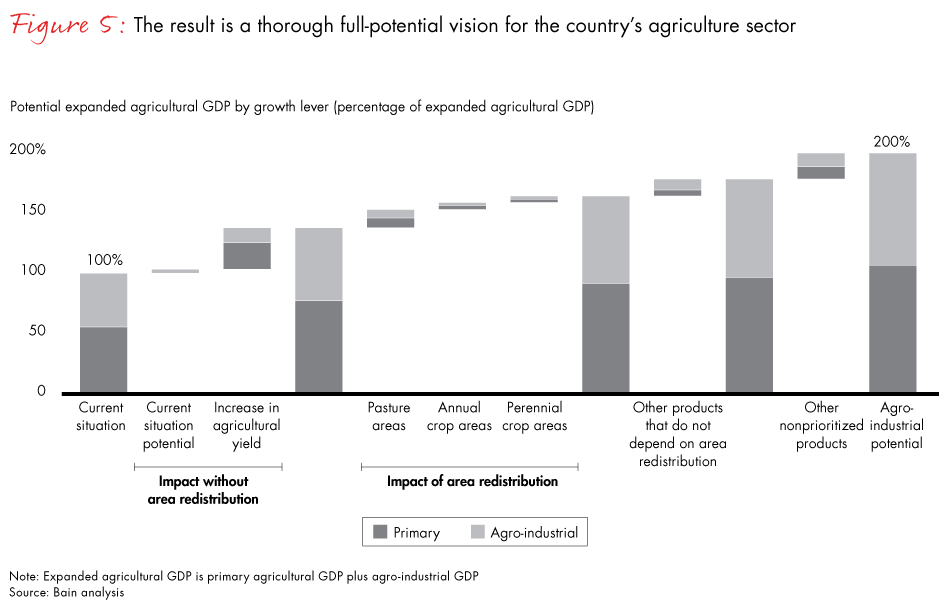
Agriculture 3.0, explained
When Agriculture 3.0 is fully available, with digital capabilities widely implemented and connected, producers will be able to increase yields and lower costs with a host of new technology solutions. It will look like this:
- Better and cheaper satellite mapping, enhanced by more precise crop identification and growth algorithms, allows for improved monitoring of crop status.
- Field sensors collect data on nutrient quality, moisture, weather and other factors that affect yields.
- Super-accurate yield maps determine precise seed and input prescriptions for each plot.
- Variable-rate seeders and applicators provide each plot with the optimal amount of inputs.
- Autonomous equipment navigates fields with limited or no oversight.
- Drones survey plots to monitor weeds, yield and soil quality.
- Real-time livestock data allows farmers to identify sick or in-heat animals.
- Farmers input data, view analyses and make decisions from mobile devices in the field.
- Data is stored in a central repository and in the cloud, where it can be accessed for analysis.
- Farmers access data from their home control centers, or from online portals offered by precision agriculture companies.
- Real-time data on machine performance helps predict and prevent maintenance issues, increasing equipment uptime.
Already, some producers are stepping into this future. For example, India’s Chitale Dairy tracks its cows’ location and status via radio-frequency identification, maintaining a database on the herd. But such digital capabilities will be commonplace on the farm only after three waves of innovation.
Wave 1 involves adopting point solutions that are commercially available today, such as GPS, automated steering, sprayer control, logistics, drones, satellites, custom application of inputs, and advanced water, weather and yield sensors.
Wave 2 will involve implementing decision support systems as they evolve, such as predictive maintenance, autonomous vehicles and drones, and real-time, multi-node data and analytics.
Wave 3 will require connected ecosystems: autonomous fleets; full-farm solutions with interconnected telematics; real-time, multi-node data and analytics; and automated real-time application of inputs.
Delivering the farm of the future means overcoming numerous challenges, everything from establishing regulations and standards for autonomous vehicles to allaying producer concerns about the security and ownership of sensitive farm data. Companies developing digital solutions also need to create trust with farmers, prove the value of technologies such as data-based growing and build an installed base to make their offerings profitable.
José de Sá, a partner with Bain's Agribusiness practice, discusses how digital can help governments in developing economies derive better insights into how to invest in agricultural activity.
Why it’s government’s role
Farming is the world’s oldest economic activity, so there’s no shortage of professionals or institutions with an expert opinion on the agricultural chain. The problem is that, as in the ancient Indian parable of the seven blind people and the elephant, while each might be right about part of the solution, they are all wrong on the whole. And here lies the importance of governments playing the central developmental role in their respective countries.
Our experience shows that governments achieve the best results when they take the lead in understanding the bigger picture, create the framework for collaboration and use rigorous analysis to guide their decisions. In the most successful cases, governments establish a pro-business environment that allows the private sector to contribute the best possible intelligence on the status quo, and then actively participate in discussions involving where to play (which crops to plant and where) and how to win (what tools, programs and incentives to use). Governments then carry this collaborative approach through to implementation, communicating clearly about the path forward with all stakeholders to establish a convergence of purpose.
When a government fails to be proactive, it often ends up becoming either a roadblock to development or an unfocused protectionist machine that, from a socioeconomic perspective, ultimately creates more harm than good.
Getting started
To achieve full-potential agriculture, governments need to fight the fragmentation of responsibilities that we find in many countries by consolidating leadership for the entire value chain, from the primary crop activity to the industrial steps downstream. The governance structure should enable leaders to quickly make decisions and take action on key elements such as incentives, financing, infrastructure and education.
This setup not only promotes agility and effectiveness, it also sends a strong signal to the investment community, which will quickly recognize the value of a pro-business environment. By engaging the private sector, both in general and through crop-specific committees, governments can make companies their partners in a full-potential strategy.
With all this in place, governments can define the strategy. That entails:
- analyzing the status quo;
- strategically characterizing the various crop value chains from a global perspective;
- launching remedial data-gathering efforts to provide vital pieces of missing information;
- running various optimization scenarios;
- understanding the trade-offs and making the appropriate choices; and
- determining the enabling elements—that is, the incentives to put in place, the infrastructure to build, the financing to offer and the education to provide.
1 Agro-ecological characteristics include land slope, depth, texture, stoniness, pH, salinity, toxicity, fertility, drainage, precipitation, temperature, humidity, altitude, irrigation and others, the combination of which determines potential crop yields.
José de Sá is a partner in Bain & Company’s São Paulo office and a member of the firm’s Social & Public Sector practice. Frederic Declercq is a Bain partner based in São Paulo, and Dalton Maine and Fernando Martins are partners based in Chicago; all three are members of the Agribusiness sector of Bain’s Industrial Goods & Services practice.




